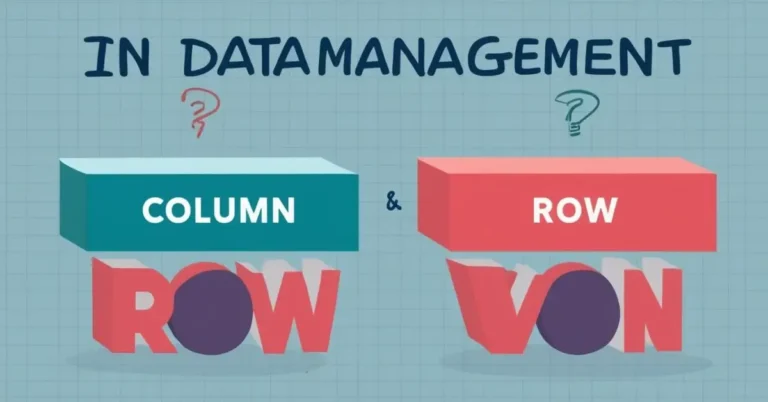In the realms of data management, spreadsheets, databases, and general computing, the terms “column” and “row” are frequently encountered. While they are basic concepts, their correct usage is crucial for organizing, analyzing, and interpreting data effectively. The distinctions between columns and rows might seem trivial, but they play a fundamental role in the structure and functionality of data systems.
This article delves into the detailed differences between columns and rows, their applications, significance in various domains, and best practices for their use. Understanding these concepts is essential not only for data professionals but also for anyone who works with data regularly.
What Are Columns and Rows?
At their core, columns and rows are structural components of a table, which is a common format used to organize data. Let’s define each term more precisely.
1. Columns:
- Definition: A column is a vertical series of cells in a table or spreadsheet. Each column contains data related to a specific field or attribute.
- Characteristics: Columns are often labeled with letters (A, B, C, etc.) in spreadsheets like Microsoft Excel or Google Sheets. In databases, columns represent fields that hold the same type of data across multiple records.
- Example: In a table listing employee information, a column might contain all the employees’ names, another might contain their job titles, and another their salaries.
2. Rows:
- Definition: A row is a horizontal series of cells in a table or spreadsheet. Each row contains data for a specific record or item.
- Characteristics: Rows are typically numbered (1, 2, 3, etc.) in spreadsheets. In databases, rows represent individual records where each record consists of various fields (columns).
- Example: In the same employee table, a row might contain all the information (name, job title, salary) related to a single employee.
Understanding the basic definitions of columns and rows is the first step towards effectively organizing and interpreting data.
Differences Between Columns and Rows
Now that we’ve defined columns and rows, let’s explore the key differences between them. These differences are crucial for understanding how data is organized and accessed in various contexts.
1. Orientation:
- Columns: Columns run vertically from top to bottom. They are aligned with the vertical axis.
- Rows: Rows run horizontally from left to right. They are aligned with the horizontal axis.
2. Labeling:
- Columns: In spreadsheets, columns are labeled with letters (e.g., A, B, C). In databases, columns are labeled with the field name (e.g., “Employee Name,” “Salary”).
- Rows: Rows are labeled with numbers (e.g., 1, 2, 3). Each row corresponds to a specific record or item.
3. Functionality:
- Columns: Columns are used to store specific types of data. For example, in a database of books, one column might store book titles, another might store author names, and another might store publication dates.
- Rows: Rows represent complete records. In the same book database, one row would contain all the information about a single book (title, author, publication date, etc.).
4. Data Manipulation:
- Columns: When analyzing data, you often manipulate columns to perform operations like summing, averaging, or filtering specific fields. For example, you might calculate the average salary of employees by working with the “Salary” column.
- Rows: Rows are often manipulated when you need to access or modify entire records. For instance, you might delete a row if an employee leaves the company, removing all associated data in one go.
5. Access Patterns:
- Columns: In many data analysis scenarios, you access data by column. For example, when creating a chart, you might select the data in a particular column to plot on the y-axis.
- Rows: When accessing data for a specific entity or record, you typically look at the row corresponding to that record.
These differences highlight how columns and rows serve distinct but complementary purposes in data organization and analysis.
Importance of Columns and Rows in Various Contexts
Columns and rows are integral to numerous fields, including database management, spreadsheet usage, and programming. Let’s examine their importance in various contexts.
1. Databases:
- Columns: In a relational database, columns are known as fields or attributes, and they define the type of data that can be stored in each record. For example, in a customer database, columns might include “Customer ID,” “Name,” “Email,” and “Purchase History.” Each column is associated with a specific data type (e.g., text, number, date).
- Rows: Rows in a database represent individual records. Each row contains a unique instance of data that conforms to the structure defined by the columns. For example, one row might represent a single customer’s data, including their ID, name, email, and purchase history.
2. Spreadsheets:
- Columns: In spreadsheets, columns are often used to categorize data by type. For example, in a budget spreadsheet, you might have columns for different expense categories such as “Rent,” “Utilities,” “Groceries,” and “Entertainment.”
- Rows: Rows in spreadsheets are typically used to record data over time or across different entities. For instance, each row might represent a different month’s expenses or the spending of a different person.
3. Programming:
- Columns: In programming, particularly in data science, columns of data are often handled as vectors or arrays. For example, in Python’s pandas library, a column is represented as a Series object, which allows for powerful operations like filtering, aggregation, and transformation.
- Rows: Rows in programming are often used to represent records in a dataset. For example, in a DataFrame (a common data structure in Python), each row is an entry that can be indexed and accessed using a label or index number.
4. Business Analytics:
- Columns: In business analytics, columns are crucial for segmenting data into manageable categories. This segmentation allows analysts to perform detailed analysis, such as calculating key performance indicators (KPIs) for specific metrics.
- Rows: Rows are important in business analytics for tracking individual performance data. For instance, each row might represent a sales transaction, enabling analysts to track sales over time and by different criteria.
Best Practices for Using Columns and Rows
Effectively managing and utilizing columns and rows can significantly enhance data analysis and decision-making. Here are some best practices:
1. Consistent Naming Conventions:
- Use clear and descriptive names for columns to ensure that anyone working with the data can easily understand what each column represents.
- Avoid using spaces or special characters in column names, especially in databases and programming, where they can cause issues.
2. Data Integrity:
- Ensure that each column contains only one type of data. For example, do not mix numbers and text in the same column.
- Validate data at the point of entry to ensure consistency and accuracy in each row.
3. Optimize for Performance:
- When working with large datasets, consider the order of columns and rows to optimize performance. For example, place frequently accessed columns together to minimize retrieval time.
- In databases, indexing columns that are commonly used in queries can speed up data access.
4. Keep Data Organized:
- Maintain a logical order for columns, grouping related fields together. For example, in a customer database, keep contact information fields like “Phone Number” and “Email” next to each other.
- Avoid unnecessary columns or rows that do not add value to the analysis.
5. Documentation and Metadata:
- Document the purpose and content of each column and row, especially in complex datasets. This can include descriptions of each field and its data type.
- Use metadata to provide additional context about the data, such as the source of each column or the date when the data was last updated.
6. Consistent Data Formats:
- Ensure that each column has a consistent data format, such as using the same date format throughout a date column or maintaining consistent decimal places in numerical columns.
- Regularly audit the data to check for inconsistencies or errors in the rows.
7. Avoid Redundancy:
- Minimize redundancy in columns and rows by ensuring that each piece of data is only stored once. For example, in a database, avoid duplicating information across multiple tables by normalizing the data.
- Use primary keys in rows to uniquely identify each record, preventing duplicate entries.
8. Accessibility:
- Make sure that the data in columns and rows is accessible to those who need it. This can involve setting appropriate permissions in databases or using shared spreadsheets with collaborative features.
- Use sorting and filtering tools to help users quickly find the rows and columns they need to work with.
Applications in Real-World Scenarios
Columns and rows are utilized in countless real-world applications. Here are a few examples:
1. Financial Reporting:
- In financial reporting, columns might represent different accounts (e.g., “Revenue,” “Expenses,” “Profit”), while rows represent specific time periods (e.g., months or quarters).
- Financial analysts use this structure to track performance over time, identify trends, and make projections.
2. Inventory Management:
- In inventory management systems, columns might represent product attributes (e.g., “Product ID,” “Description,” “Quantity in Stock”), while rows represent individual products.
- This organization allows for efficient tracking of stock levels, reorder points, and inventory valuation.
3. Healthcare Records:
- In electronic health records (EHR) systems, columns might represent patient attributes (e.g., “Name,” “Date of Birth,” “Medical History”), while rows represent individual patients.
- Healthcare providers use this structure to maintain accurate records, track patient care, and ensure compliance with medical regulations.
4. Academic Research:
- In academic research, columns might represent variables in a study (e.g., “Age,” “Gender,” “Test Scores”), while rows represent individual participants.
- Researchers use this data structure to perform statistical analysis, draw conclusions, and publish findings.
5. Customer Relationship Management (CRM):
- In CRM systems, columns might represent customer attributes (e.g., “Name,” “Email,” “Purchase History”), while rows represent individual customers.
- Businesses use this organization to manage customer interactions, improve sales, and enhance customer satisfaction.
Conclusion
Columns and rows are fundamental components of data organization that play a crucial role in a wide range of applications, from database management and spreadsheets to programming and business analytics. Understanding the differences between columns and rows, as well as how to effectively use them, is essential for anyone who works with data.
By following best practices and applying the concepts of columns and rows in real-world scenarios, you can enhance data integrity, improve efficiency, and make more informed decisions. Whether you’re managing a simple spreadsheet or a complex database, the careful organization of columns and rows will serve as the backbone of your data strategy.

